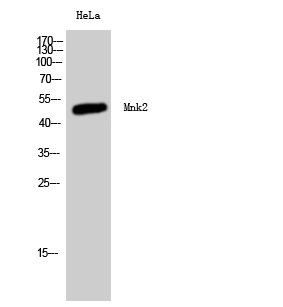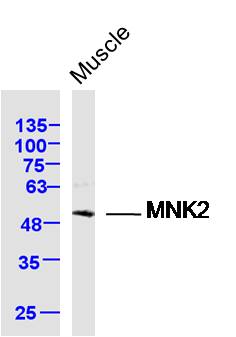
WB analysis of HeLa cell lysate using GTX34078 MNK2 antibody.
MNK2 antibody
GTX34078
ApplicationsWestern Blot
Product group Antibodies
TargetMKNK2
Overview
- SupplierGeneTex
- Product NameMNK2 antibody
- Delivery Days Customer9
- Application Supplier NoteWB: 1:500-1:2000. *Optimal dilutions/concentrations should be determined by the researcher.Not tested in other applications.
- ApplicationsWestern Blot
- CertificationResearch Use Only
- ClonalityPolyclonal
- Concentration1 mg/ml
- ConjugateUnconjugated
- Gene ID2872
- Target nameMKNK2
- Target descriptionMAPK interacting serine/threonine kinase 2
- Target synonymsGPRK7, MNK2, MAP kinase-interacting serine/threonine-protein kinase 2, G protein-coupled receptor kinase 7, MAP kinase interacting serine/threonine kinase 2, MAP kinase signal-integrating kinase 2, MAPK signal-integrating kinase 2
- HostRabbit
- IsotypeIgG
- Protein IDQ9HBH9
- Protein NameMAP kinase-interacting serine/threonine-protein kinase 2
- Scientific DescriptionThis gene encodes a member of the calcium/calmodulin-dependent protein kinases (CAMK) Ser/Thr protein kinase family, which belongs to the protein kinase superfamily. This protein contains conserved DLG (asp-leu-gly) and ENIL (glu-asn-ile-leu) motifs, and an N-terminal polybasic region which binds importin A and the translation factor scaffold protein eukaryotic initiation factor 4G (eIF4G). This protein is one of the downstream kinases activated by mitogen-activated protein (MAP) kinases. It phosphorylates the eukaryotic initiation factor 4E (eIF4E), thus playing important roles in the initiation of mRNA translation, oncogenic transformation and malignant cell proliferation. In addition to eIF4E, this protein also interacts with von Hippel-Lindau tumor suppressor (VHL), ring-box 1 (Rbx1) and Cullin2 (Cul2), which are all components of the CBC(VHL) ubiquitin ligase E3 complex. Multiple alternatively spliced transcript variants have been found, but the full-length nature and biological activity of only two variants are determined. These two variants encode distinct isoforms which differ in activity and regulation, and in subcellular localization. [provided by RefSeq, Aug 2011]
- Storage Instruction-20°C or -80°C,2°C to 8°C
- UNSPSC12352203






